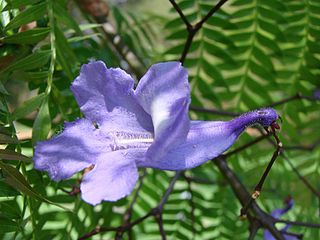
Jacaranda is a genus of 49 species of flowering plants in the family Bignoniaceae, native to tropical and subtropical regions of the Americas.

Gentianaceae is a family of flowering plants of 103 genera and about 1600 species.

Bombax is a genus of mainly tropical trees in the mallow family. They are native to western Africa, the Indian subcontinent, Southeast Asia, and the subtropical regions of East Asia and northern Australia. It is distinguished from the genus Ceiba, which has whiter flowers.

Olea is a genus of about 40 species in the family Oleaceae, native to warm temperate and tropical regions of the Middle East, southern Europe, Africa, southern Asia, and Australasia. They are evergreen trees and shrubs, with small, opposite, entire leaves. The fruit is a drupe. Leaves of Olea contain trichosclereids.

Bignonia is a genus of flowering plants in the family Bignoniaceae. Its genus and family were named after Jean-Paul Bignon by his protégé Joseph Pitton de Tournefort in 1694, and the genus was established as part of modern botanical nomenclature in 1753 by Carl Linnaeus. Species have been recorded from the southern USA, Central to most of South America.

Echinodorus, commonly known as burhead or Amazon sword, is a genus of plants in the family Alismataceae, native to the Western Hemisphere from the central United States to Argentina. Its scientific name is derived from Ancient Greek echius – "rough husk" - and doros – "leathern bottle" - alluding to ovaries, which in some species are armed with persistent styles, forming prickly head of fruit. Some of the species are commonly cultivated in artificial aquatic habitats.

Angelonia is a genus of about 30 species which occur from Mexico to Argentina and is classified in the Plantaginaceae. They are herbaceous plants occurring mainly in arid and semi-arid habitats. Most Angelonia species can be found in Northeastern Brazil in the Seasonally Dry Tropical Forest namely Caatinga. The flowers of Angelonia are highly specialized for pollination because they have hairs in the inner corolla, which produces oils collected by oil bee pollinators, especially of the genus Centris.

Lippia is a genus of flowering plants in the verbena family, Verbenaceae. It was named after Augustus Lippi, (1678-1705), a French naturalist and botanist. He was killed in Abyssinia. The genus contains roughly 200 species of tropical shrubs that are found around the world. Plants are fragrant due to their essential oils, which vary between species but may include estragole, carvacrol, linalool, or limonene. The leaves of certain species, such as L. graveolens, can be used as a culinary herb similar to oregano.

Chionanthus, common name: fringetrees, is a genus of about 150 species of flowering plants in the family Oleaceae.

Stachytarpheta is a plant genus in the verbena family (Verbenaceae). The flowers are rich in nectar and popular with many butterflies, such as the South Asian crimson rose, Malabar banded swallowtail, and grass yellow Hummingbirds, especially small species like Lophornis coquettes, Chlorostilbon emeralds, and Discosura thorntails, are especially attracted for nectar. Several species in this genus are known as porterweeds.

Spigelia is a genus of flowering plants in the family Loganiaceae. It contains around 60 species, distributed over the warmer parts of the Americas, from the latitude of Buenos Aires to the Southern United States. It was named after Adriaan van den Spiegel by Carl Linnaeus in his 1753 Species Plantarum; the type species is Spigelia anthelmia. Pinkroot is a common name for plants in this genus.

Microlicia is a genus of flowering plants in the family Melastomataceae, native to northern South America, particularly Brazil. They tend to be subshrubs.
Casselia is a small genus of flowering plants in the verbena family (Verbenaceae) first named in 1823. Plants in the genus Casselia are native to South America.

Corynabutilon is a genus of flowering plants in the family Malvaceae, native to southern Chile and Argentina. They are shrubs or small trees.
Calolisianthus is a genus of flowering plants belonging to the family Gentianaceae.
Conobea is a genus of flowering plants belonging to the family Plantaginaceae.












